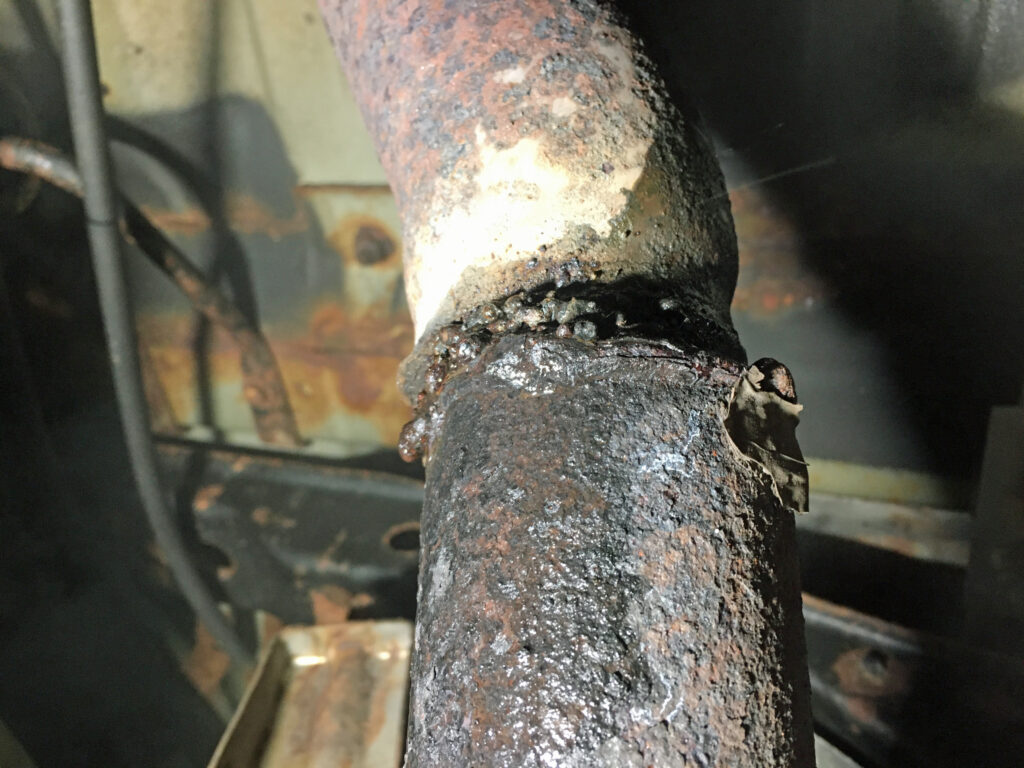A few weeks ago, I wrote about buying a 182,000-mile 2008 Nissan Armada as a tow vehicle / stuff hauler. Among my requirements were the very left-brain bullet that it should be a tool and not a project car, and the very right-brain one that I shouldn’t hate it.
Well, funny story.
The truck’s low $3,250 purchase price had several known issues baked into it. Although the exhaust wasn’t loud, holding my hand over the tailpipe revealed a big leak. The illumination of the Check Engine Light (CEL) was due to several catalytic converter inefficiency codes, so there was the specter that the cats might be dirty. Obvious thunks and clunks from the front end indicated that the struts were likely bad. And post-purchase, once I got it home and drove it around a bit, a few more issues elbowed their way onto the to-do list. There’s a metallic whine from the front of the engine, coupled with some noise when turning the steering wheel, both of which are worse when things are cold, indicating serpentine belt / tensioner / idler / power steering pump issues. And a number of leaks from the engine compartment whose sources need to be identified. And an emergency brake that, while it might sneak through inspection, wouldn’t do diddly in an actual emergency.
I decided to deal with the exhaust first. Even though the truck had an inspection sticker on it that was good through August, in Massachusetts the sticker is tied to the plate number. The law is that you need to get an inspection within seven days of purchase. If you don’t, and if you’re stopped for some other issue and the officer checks your inspection sticker and sees that it’s from the previous owner, it’s a moving violation that adds points to your license.
I hose-clamped a rubber glove to the tailpipe to force exhaust through the leaks, crawled under the truck and ran my hand along the exhaust, and found a large leak from a highly-questionable weld attaching the tailpipe to the muffler.

Good lord that’s cringe worthy.
Hoping that I could get this taken care of quickly and cheaply, I took the truck to a local exhaust shop who has bailed me out a few times over the decades. They put it up on the lift, and to no great surprise, found the exhaust leaking from three places. The welded tailpipe joint was the worst, but there was also a substantial leak from a split in the seam at the top of the muffler, and a small leak from the flange at the back of one of the four catalytic converters (primary and secondary for each of the two banks of cylinders). Because the flange and fasteners looked paper-thin from corrosion, the shop recommended cutting off the flange, welding new pipe to it, and running it to a new muffler and tailpipe. The estimate for everything was $1,200. So much for “cheaply.”

The right rear cat flange was scary.
Now, I have a long history with exhaust work. I’ve certainly done my share of patching holes in pipes with soup cans and hose clamps. When I bought the Bavaria ten years ago, it had several holes in the muffler, including a three-finger special. I bought a section of chimney pipe at Home Depot, split it open, wrapped it around, and secured it with four big hose clamps. It’s still on there, even though three years ago I bought a proper used OEM Eberspächer muffler on eBay. There’s no need to install it yet. The aluminum-wrapped muffler is still working fine.

Before…

…and after. The Bavaria’s near-permanent chimney-wrapped muffler.
Obviously there are times when the whole exhaust is a spiderweb of rusty garbage and there’s no choice but to rip the whole thing out and do it all stem to stern. However, “all” means one thing on a car like a 2002 where there are only three pieces (headpipe, center resonator, and muffler), and something far more intimidating on a modern car like the Armada with four catalytic converters, at least one of which was shown to have a leaky flange that would probably crumble if I looked at it the wrong way. In this case, “doing it all” can be prohibitively expensive.
So I tried the bare minimum first. I cleaned both the tailpipe weld and the seam on top of the muffler with a wire brush, shoveled muffler putty into them with a rubber-gloved hand, and let it dry overnight. In the morning I took the truck in for inspection.
It failed. The technically-illegal-though-inconspicuous previous inspection sticker had been replaced with a big red “R,” for which I could be stopped and ticketed at any time.

Literally a scarlet “R.”
I did a post-mortem leak test (which is what I should’ve done before I took it in for inspection) and found that my putty job around the poor tailpipe weld wasn’t even close to sealing it. I packed in even more. It looked ridiculous, and still didn’t seal.

Yeesh!
To get the exhaust tight enough that it would pass inspection, I clearly needed to do more. Tightly coupled with that was the issue of where the work would occur. My garage has the 3.0CSi, the M Coupe, and Hampton the 49,000-mile survivor 2002 in it for the winter. Of those, only the M Coupe can really sit outside for days at a time without my hearing the screams of 50-year-old German metal as it rusts. The putty-shoveling went on in the driveway during periods of clear weather, but a larger exhaust job that might span several days needed the level floor and weather protection of the garage. I did manage to get Hampton raised much higher than I usually jack the mid-rise lift to, and I found that I was able to get the nose of the Armada beneath its butt. That let me work beneath the back of the truck, but I’d be out of luck if I needed to jack up the nose.

Playing garage Tetris.
I looked on RockAuto and found several sub-$200 cat-back Armada exhaust systems. I entertained the idea of taking a Sawzall to the muffler pipes and splicing on a new muffler (thereby leaving the thin cat flange alone), but decided to try a less-invasive and more, um, hacky approach first.
I cut out the bulbous weld-and-putty leak factory and carefully measured the pipes on both sides so I could order the correct butt-splice band clamp. I laughed out loud to myself when I discovered that the two pipes weren’t the same size—the outlet pipe of the muffler was 2.25 inches, but the tailpipe diameter was a quarter-inch larger. No wonder the thing didn’t seal. I ordered a 2.5-to-2.25-inch reducer on Amazon (reportedly with a 2.5-in inner diameter and a 2.25-inch outer diameter). Unfortunately, when it arrived, I found that it fit over the tailpipe, but didn’t fit inside the muffler pipe; instead, it was exactly the same size. Fortunately, a local auto parts store had a 2.25-to-2.25-inch adapter. It wasn’t pretty, but two adapters, three clamps, and half a tube of muffler cement later, I had things sealed up. This time I did test it with my hand, and it felt tight to me. If it was leaking through the cat flange, it was minor.

Leak NOW, you little…
The next morning I took it in for inspection. I felt like a guilty defendant waiting for the jury to come back with an “innocent” verdict. It passed. Does this make me a bad person?
So, the Armada is legal. That just leaves the front struts. And the codes triggering the Check Engine Light. And the serpentine belt issues. And the fluid leaks. And the e-brake.
But it’s not a project car. And I don’t hate it.
Yet.
—Rob Siegel
____________________________________
Rob’s newest book, The Best of The Hack Mechanic, is available here on Amazon, as are his seven other books. Signed copies can be ordered directly from Rob here.





















